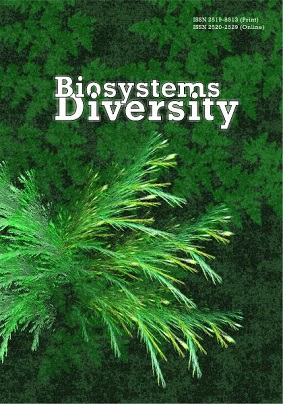Reproductive potential of yellow water-lily (Nuphar lutea) in the conditions of lake ecosystems
Reproductive potential of yellow water-lily (Nuphar lutea) in the conditions of lake ecosystems
Author(s): O. A. Lebedeva, E. A. Belyakov, A. G. LapirovSubject(s): Human Ecology, Sociobiology, Environmental interactions
Published by: Дніпропетровський національний університет імені Олеся Гончара
Keywords: morphology of fruits; seed productivity; buoyancy of fruits; seed; germination; initial stages of ontogenesis;
Summary/Abstract: Nuphar lutea (L.) Sm. (Nymphaeaceae Salisb.) belongs to the category of highly active cenose-forming plants in water bodies and water flows. The material for study of morphological peculiarities and seed productivity of the fruits of this species was collected mainly in the lake ecosystems of the Central Part of European Russia and Republic of Belarus. In the study we used biomorphological and ontogenetic approaches. Seed productivity was surveyed by direct count of number of seeds in the fruit. By abundance (in descending order), the significant reliable inter-lake differences in a number of morphological parameters of the fruit fall into the following sequence: number of rays of stigma of fruit (in six pairs of lakes) > length of fruit (in four pairs of lakes) > diameter of the stigma of fruit (in three pairs of lakes) > diameter of fruit (in two pairs of lakes) > length of the neck of the fruit (in one pair of lakes). Intra-regional differences in certain morphological parameters of fruits (by number of rays of stigmas) were most notably manifested only in the Belarus lakes which are similar by trophic status. All the differences in the fruits’ morphology could be due to differences in the habitat by the amount of nutrients in water and soil. The amount of seed productivity of the fruits from N. lutea varies broadly. Analysis of this parameter depending on the character of soils in which the plants grew indicated reliable results only in the case of muddy (296 ± 81) and sandy soils (179 ± 13). We determined that distribution of generative diasporas of N. lutea across large distances is related not only to presence of floating ability in the seeds, but also the “multi-step” process of their release: first – mericarps from fruits, and then seeds from mericarps. In the experimental conditions, most seeds directly sunk to the bed (70%) and the rest continued to float on the surface of the water during a month. Low germination of the seeds of the water-lily in the laboratory conditions (4–6%) with use of different means and terms of dry stratification was due to the fact that they have an organic morphophysiological intermediate type of rest. Having such a mechanism causes portioned and prolonged germination, allowing the species to survive in non-favourable conditions and accumulate generative diaspores in the soil. Despite the fact that the initial stages of ontogenesis in the laboratory and natural conditions have no significant differences, we found polyvariance in their tempo of development. First of all, this is related to different dates of transition of the plant from one age state to another. In the case of N. lutea, one should also note the morphological polyvariance of ontogenesis related to change in morphologic characteristics of plants depending on the water level. The obtained results give a more complete picture of the peculiarities of generative reproduction of N. lutea, necessary for understanding the ecosystem role of this plant and its impact on biological processes in water bodies.
Journal: Biosystems Diversity
- Issue Year: 28/2020
- Issue No: 1
- Page Range: 60-67
- Page Count: 8
- Language: English

